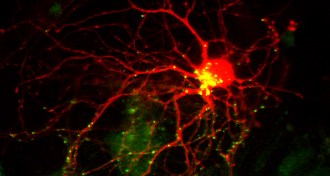Feature
-

Better by Design
Avoiding undesirable traits from the start could help chemists make molecules less meddlesome.
-

-

Ice in Motion
As frozen lands disintegrate, researchers rush to catch the collapse.
-
 Health & Medicine
Health & MedicineMemories Can’t Wait
Researchers rethink the role of amyloid in causing Alzheimer’s
-

-

-

Cerebral Delights
The amygdala, a part of the brain known for its role in fear, also helps people spot rewards — and go after them.
By Susan Gaidos -

Rivers in the sky
Atmospheric bands of water vapor can cause flooding and extreme weather
-

In the Zone
Evolution may have trained the mind to see scoring streaks — even where they don't exist.
By Bruce Bower -

Sizing up the Electron
Measuring the inner shape of the famous particle could help solve a cosmic mystery.
-

-
